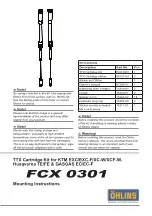
41
II. Safety Considerations and Accurate Temperature Control
For safety critical and non-typical organic reactions
(especially polymeric reactions) or for use
with heaters other than heating mantles the user must either 1) monitor the reaction closely to verify
the tuning parameters are appropriate for the current application, or 2) autotune the controller for the
application. For any safety critical or high value reaction, call J-KEM to discuss your application
with an engineer prior to beginning.
Your J-KEM controller is capable of regulating virtually any application to ± 0.1
o
C if the controller is tuned
to the application being heated. Since it’s possible that the tuning parameters are not set correctly for your
application, the user must monitor a new reaction to verify the controllers operation. A short primmer on tuning is
presented below, a more detailed explanation is presented in Sections 2.1 and 4.1.
Tuning is the process that matches the control characteristics of the controller to the heating characteristics
of the process being controlled. The controller uses a PID (Proportional, Integral, Derivative) algorithm to regulate
heating. Each of the terms in the PID equation have a constant that
scales
the equation to the process being heating.
These constants (plus two other related terms) are collectively known as the ‘tuning constants’ and for the most part
they are expressed in units of time, since they represent delay times, rate of heat transfer times, and rate of error
accumulation. The relative value of each constant depends on the physical characteristics of the process being
heated. For example, for the same amount of input power, the rate of heat transfer is twice as high for hexane as
compared to water, since the coefficient of heat for hexane is 0.54 calories/g/
o
C and water is
1.0 calorie/gram/
o
C. That means that 1000 watt-seconds of input power will raise the temperature of 10 g of
hexane 44
o
C while the same amount of power causes a 24
o
C rise in water. In theory, the tuning constants needed
to heat hexane are different from those to heat water. Fortunately, your J-KEM controller is self-adaptive and is
able to adapt it’s heating characteristics for different solvents such as hexane and water. Even with the controller’s
self-adaptive algorithms, the tuning constants have to be reasonably close to a proper set or the controller will not
produce stable temperature control
(see Section 2.1).
When a controller is shipped, the default set of tuning constants loaded into the controller are those
appropriate for heating
typical
organic reactions (i.e., small molecule chemistry in low boiling (< 160
o
C ) organic
solvents) using heating mantles, since this is the most common application for J-KEM controllers.
Since it’s
impossible for J-KEM to predict the application the controller will be used for, the researcher must be aware
of the possibility that the tuning constants loaded into the controller may not be a set that results in stable
temperature control. It’s the researcher’s responsibility to monitor the temperature regulation of a reaction.
If you encounter a process that your J-KEM controller does not heat with stability, you have two resources.
Autotune Feature.
Your controller has and autotune feature that when turned on (see Sections
2.1 & 2.2) automatically determines the proper tuning constants for your application and then loads them into
memory for future use.
J-KEM Technical Assistance.
If you have an application you wish to discuss, call us, we’re always anxious
to help our users.
For an additional description of the PID algorithm and the concept of tuning, see Sections 2 and 4.1.






































